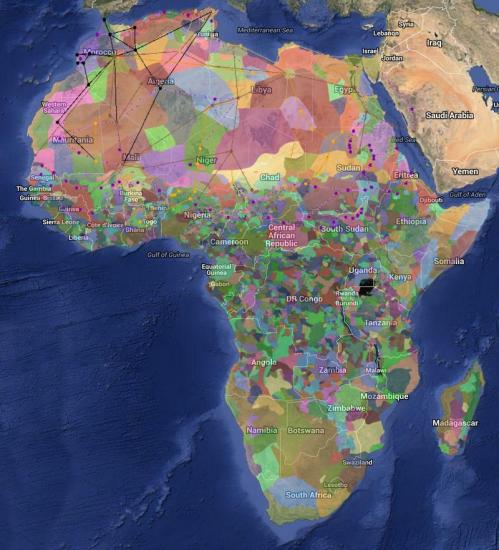Max Fisher
Source - http://www.vox.com/2015/11/10/9698574/africa-diversity-map
If you haven't already seen this Harvard University map of ethnicity in Africa, based on data from a 2001 book edited by anthropologist Marc Leo Felix, it is really worth taking in:
 Each color roughly corresponds to an ethnic group that constitutes the majority in that region, based on how people self-identify. Ethnicity is notoriously difficult to measure and demarcate — everyone sees their own ethnic identity a little differently — but the results here roughly track with a 1959 ethnography by anthropologist George Murdock and with a 2002 Harvard Institute study on ethnic diversity.
Each color roughly corresponds to an ethnic group that constitutes the majority in that region, based on how people self-identify. Ethnicity is notoriously difficult to measure and demarcate — everyone sees their own ethnic identity a little differently — but the results here roughly track with a 1959 ethnography by anthropologist George Murdock and with a 2002 Harvard Institute study on ethnic diversity.
That latter study found that sub-Saharan African contained many of the most ethnically diverse countries on Earth, including the two most diverse: Uganda and Liberia. And the above map certainly suggests enormous ethnic diversity across western and central Africa.
You can play around with Harvard's interactive map, overlaying other variables and studies, here. One interesting thing to look at is linguistic diversity, which, according to another data set the map uses, is also enormously diverse across the same regions. This isn't shocking: Language and ethnic diversity often (though not always) go hand in hand. Language, after all, is a basic building block of any social community, and ethnicity is often just another word for community.
One thing to keep in mind when looking at this map or any study on ethnicity is just how flexible ethnic identity can be. Any given person might hold several ethnic identities he or she uses interchangeably, and they can shift over time. That's just as true in the US as it is in, say, Uganda or anywhere else.
Ethnic identity can and does change. People will often define their ethnic identities more narrowly in times of economic hardship, physical insecurity, or political conflict. As the 2002 Harvard study noted, for example, ethnic identities in Somalia narrowed considerably after that country's famine and civil war. In other words, someone who identified as ethnically Dir before the famine and war might, if asked years later, have identified primarily as Issa (a subgroup of Dir).
That's not say that conflict or resource scarcity caused sub-Saharan Africa's ethnic diversity. After all, famine and civil war in China did not permanently fracture ethnic Han identity — one of the world's largest ethnic groups — nor has Indonesia's recent peace and prosperity ended its ethnic diversity.
Rather, it seems more likely that much of sub-Saharan Africa's ethnic diversity could be linked to geography. Highland regions, particularly those that are sparsely populated, are often more ethnically diverse — because transportation and communication between communities is costlier, the homogenization that has occurred in other regions over centuries and millennia might be slower or take longer. That's not to say that such regions are less developed, just that they are less linguistically and culturally — and thus, perhaps, ethnically — homogenized. You can see this elsewhere, for example in the diversity of the Caucasus Mountains region.
While this diversity can present some difficulties in, for example, introducing standardized national education materials, in other ways it is a boon. Very ethnically diverse countries can be more resistant to ethnic conflict, because no one group is large enough to dominate the others. And the fact that this diversity has survived well into the era of cheap and easy audio and video recording means that people in these communities will have an easier time capturing and preserving their cultural and linguistic heritage, unlike in parts of, say, central Europe or northeast Asia where state-imposed homogeneity occurred long before certain languages or cultural practices could be adequately recorded.